Contents
神经网络由一个个神经元组成,简单而言,每个神经元会对输入进行一些简单运算,得到输出。而训练一个网络,则是调整网络中的参数,使得输出接近学习样本的期望输出。
比如,假设有一个网络只计算 y = w * x, 初始值 w=5。把 x=10 放进这个网络,会得到 y=50. 而我们预期 y=20. 通过训练这个网络,w 将会被调整为 w=2, 输出 y=20 则符合(接近)预期。
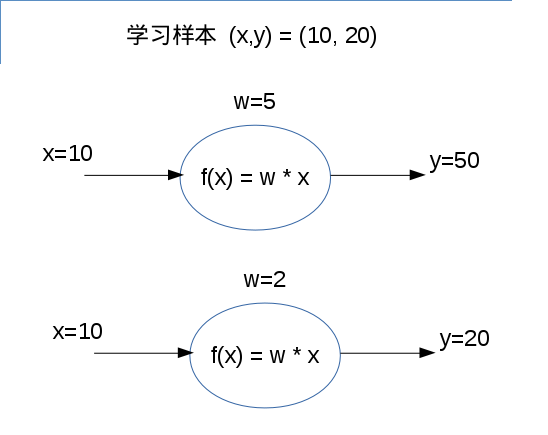
在实际应用中,一个网络会有不少参数,我们需要一个方法来调整这些参数。按我的理解,这个“调整参数”的过程就是机器学习的过程。
一个常见的神经网络,会由 Input layer, Hidden layer 和 output layer 组成。每层 layer 由众多神经元组成,Input/output layer 的神经元通常仅存储一个数值,本身不会进行运算。Hidden layer 的神经元则会对输入进行运算,将输出传给下一层。
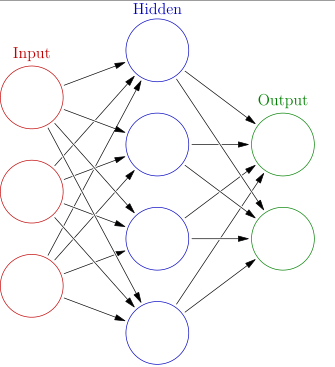
Udacity CarND-term1 Lesson 5 让我们自己去实现一个 Miniflow, 相当于一个玩具版的 Tensorflow. 通过实现 Miniflow, 可以体会到 Forward Pass 和 Backpropagation 的过程。
定义神经元
首先可以定义一个Neuron的类,之后 Input/Output/Add/Sigmoid/linear 之类的神经元也可以继承这个类。Neuron 包含__init__, forward, 和 backward 这几个函数,以及一个 value 存放它自己的值。
在__init__时,它会获取一个 inboound_neurons 的列表,这个列表记录每个输入神经元。随后,__init__会把自身神经元加到每个输入神经元的 outbound_neurons 列表中。
class Neuron:
def __init__(self, inbound_neurons=[]):
# Neurons from which this Node receives values
self.inbound_neurons = inbound_neurons
# Neurons to which this Node passes values
self.outbound_neurons = []
# A calculated value
self.value = None
# Add this node as an outbound node on its inputs.
for n in self.inbound_neurons:
n.outbound_neurons.append(self)
# These will be implemented in a subclass.
def forward(self):
"""
Forward propagation.
Compute the output value based on `inbound_neurons` and
store the result in self.value.
"""
raise NotImplemented
运算顺序 topological sort
有了神经元,且神经元之间可以连接, 我们需要决定数据的传输顺序。比如,下面网路的运算顺序可以为 A->B->C->D->E
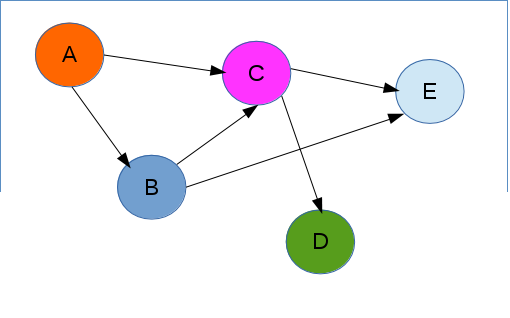
可以使用Kahn's Algorithm [7]来对拓朴进行排序,决定计算的先后顺序。
def topological_sort(feed_dict):
"""
Sort generic nodes in topological order using Kahn's Algorithm.
`feed_dict`: A dictionary where the key is an `Input` node and the value is the respective value feed to that node.
Returns a list of sorted nodes.
"""
input_neurons = [n for n in feed_dict.keys()]
G = {}
neurons = [n for n in input_neurons]
while len(neurons) > 0:
n = neurons.pop(0)
if n not in G:
G[n] = {'in': set(), 'out': set()}
for m in n.outbound_neurons:
if m not in G:
G[m] = {'in': set(), 'out': set()}
G[n]['out'].add(m)
G[m]['in'].add(n)
neurons.append(m)
L = []
S = set(input_neurons)
while len(S) > 0:
n = S.pop()
if isinstance(n, Input):
n.value = feed_dict[n]
L.append(n)
for m in n.outbound_neurons:
G[n]['out'].remove(m)
G[m]['in'].remove(n)
# if no other incoming edges add to S
if len(G[m]['in']) == 0:
S.add(m)
return L
Forward Pass
Forward Pass 是把输入的数据从前往后计算,得出最终结果的过程。
每一个神经元只需做好自己的运算即可。比如,做加法的神经元 Add, 将两个输入加起来即可得到输出。

在代码中,把两个input neuron的值加起来,就能得到当前Neuron的值(输出到下一个Neuron的值).
class Add(Neuron):
def __init__(self, x, y):
# You could access `x` and `y` in forward with
# self.inbound_neurons[0] (`x`) and self.inbound_neurons[1] (`y`)
Neuron.__init__(self, [x, y])
def forward(self):
"""
Set the value of this neuron (`self.value`) to the sum of it's inbound_nodes.
Your code here!
"""
self.value = self.inbound_neurons[0].value + self.inbound_neurons[1].value
优化参数 - Gradient Descent
重点来了。通过 Forward Pass,可以将输入的值进行一系列计算得到最终结果,但是这个结果是我们所预期的吗?通常不。所以,可以通过调整神经元的参数,使得输出的结果符合预期。
还是开头的例子,我们希望能从w=5调整为w=2,得到我们预期的输出。那么,计算机怎么知道w=2就是想要的参数呢?

定义 cost
要调整参数,首先要知道,实际结果跟预期结果相差有多远,否则我们难以评估调整的效果。这个“相差多远”可以称为Cost.
比如,可以设定Cost为 MSE (Mean Square Error)。那么w=5时,cost=(50-20)^2/1=900. w=2时,cost=(20-20)^2/1=0.
用 gradient Descent 逐步贴近
站在上帝视角,我们知道w=2时cost最小,但是身在其中的程序怎么知道w=2可以得到最小cost呢?
用数学推导的方法,我们知道:
cost=(20-wx)^{2}
x=5
要使得cost最小,易得:
w=2
在这个简单的网络中,只有一个神经元,可以用数学的方法来求出cost最小时,w的取值。
但是,当网络变得复杂之后,数学分析的方法就不奏效了。首先,数学分析的复杂度非常高,而且组合成的最终函数不一定是凸函数,不一定有唯一的最小解。这时候,数学分析几乎不可实现。
于是,可以通过“逐步贴近”的方法,找到前往最小值的方向,前进一小步,再找方向,再前进一小步,如此反复,可以逐步找到最优解。
这个方向怎样找呢?可以通过求导,找到这个函数在当前位置的斜率(Gradient),然后沿着这个斜率往下走。这个按着斜率往下走的方法,叫做 Gradient Descent.
Backpropagation
一个复杂的网络,对于特定输入值,求关于每个变量(比如w)的斜率,可以利用 chain rule 来求偏微分。
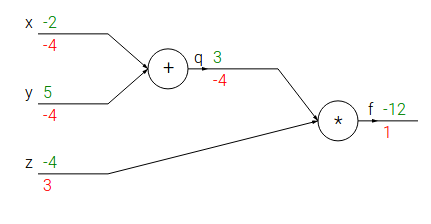
利用 chain rule, 可以求得每一个参数对于f的gradient. 在 x=-2, y=5, z=-4 的输入下,x对结果f的gradient是-4,也就是说,按照这个趋势(gradient),x增加1,f的输出会增加-4. 同理,z对结果f的gradient是3,也就是说,按照这个趋势(gradient),z增加1,f的输出会增加3.
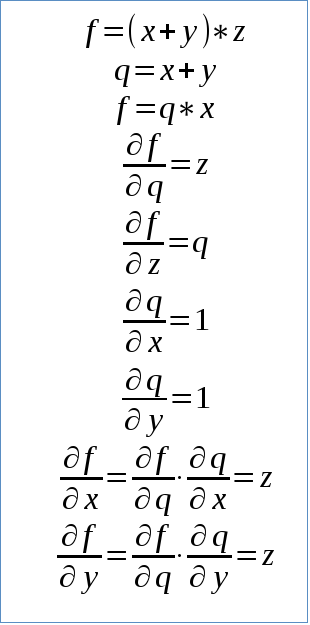
对于Backpropagation,一些运算有特定的性质。比如,"add gate"会将output(右边)的gradient,分发到所有input上。"max gate"则只将output的gradient分给其中一个input,其他input只能得到0. “multiply gate”起到交换作用,比如上图中,y的gradient是2*x=6, x的gradient是2*y=-8.
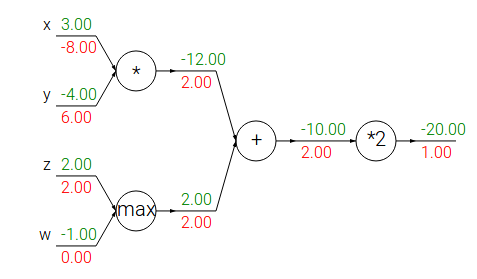
体现到代码中,Backpropagation就是反过来,将output的所有gradient求和,乘上当前Neuron的gradient, 反向传递到 input 中去。
class Sigmoid(Layer):
"""
Represents a layer that performs the sigmoid activation function.
"""
def __init__(self, layer):
# The base class constructor.
Layer.__init__(self, [layer])
def _sigmoid(self, x):
"""
This method is separate from `forward` because it
will be used with `backward` as well.
`x`: A numpy array-like object.
"""
return 1. / (1. + np.exp(-x))
def forward(self):
"""
Perform the sigmoid function and set the value.
"""
input_value = self.inbound_layers[0].value
self.value = self._sigmoid(input_value)
def backward(self):
"""
Calculates the gradient using the derivative of
the sigmoid function.
"""
# Initialize the gradients to 0.
self.gradients = {n: np.zeros_like(n.value) for n in self.inbound_layers}
# Cycle through the outputs. The gradient will change depending
# on each output, so the gradients are summed over all outputs.
for n in self.outbound_layers:
# Get the partial of the cost with respect to this layer.
grad_cost = n.gradients[self]
"""
TODO: Your code goes here!
Set the gradients property to the gradients with respect to each input.
NOTE: See the Linear layer and MSE layer for examples.
"""
sigmoid = self.value
self.gradients[self.inbound_layers[0]] += sigmoid * (1-sigmoid) * grad_cost
## 对所有output反馈的gradient作求和运算。之所以要求和,是因为“对这个input作的修改,会影响到它后续输出的所有值”.
参考文档
[1] https://brilliant.org/wiki/backpropagation/
[2] https://brilliant.org/wiki/artificial-neural-network/
[3] https://stats.stackexchange.com/questions/212619/why-is-gradient-descent-required
[4] https://www.quora.com/In-mathematical-optimization-why-would-someone-use-gradient-descent-for-a-convex-function-Why-wouldnt-they-just-find-the-derivative-of-this-function-and-look-for-the-minimum-in-the-traditional-way
[5] https://en.wikipedia.org/wiki/Gradient_descent
[6] http://cs231n.github.io/optimization-2/
[7] https://en.wikipedia.org/wiki/Topological_sorting#Kahn.27s_algorithm